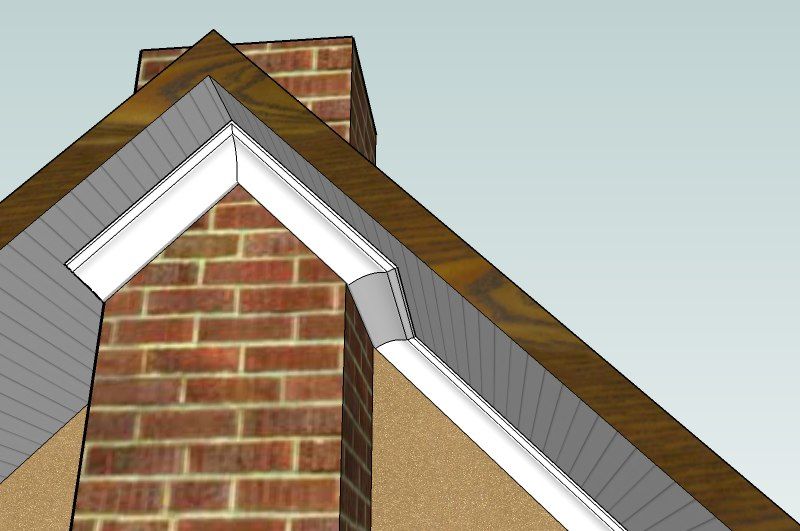i am not sure what this is called. "helical" ??
doing an ark for a synagogue.
attached is rendering. architect wants a casing that is not only arched but curved..8 inch radius. actual profile to be decided.
actual size also. but its BIG.
anyone knows what this is called? and anyone can do it? i certainly cannot.
From contributor Ji
Your picture is to small but "helical" refers to surfaces which are curved and twisted (torsioned) and corresponding to a spiral line or helix.
Curved moldings which also fit curved surfaces are termed "double-curvature".
I can do both.
From contributor B.
Your photo looks more like a deep cut profile on a flat wall half round moulding.
What we call "compound curves" are half round mouldings on a curved as vs. flat wall.
If the photo is deceptive and these are compound curves than like Jim, and others, we can produce it for you.
Here are a couple links to compound curve projects we've done:
http://www.curvedmouldings.com/projects72.html
http://www.curvedmouldi
ngs.com/projects55.html
http://www.curvedmouldings.com/projects10.html
If it is just a deep cut profile on a flat wall we can of course do that as well.
I've also sent you a private message.
BH Davis
From contributor ja
thankyou
will contact you.
at least i know what its called now. :)
From contributor Ji
Gee whiz Davis, you sure do nice work. I wouldn't think that anyone could build a business just on curved casings and such but I see now how you've done it. CNC must be the key? I love how you've programmed nearly sharp miter joints and completed molding configurations etc. Even traditional mitered handrail caps in one piece,. Wow! (I had to look close to see what was new about these).
I also think that your New England/ eastern seaboard location must be perhaps the best location for this kind of work in all the world?
I'm impressed.
From contributor B.
Geez Jim........you're making my head swell !!
Don't sell yourself short. As you know I've sent jobs your way that threw me for a loop.
The CNC has a lot to do with the 3D carving projects but only gets used to make forms for the compound curve moulding. Those get built up layers on a form matching the wall radius. Then that blank is cut to the moulding radius. Then it is fed through the moulder by various methods. A little tricky but it all seems to usually work out well.
The bigger issue is projecting the moulding radius onto the curved wall. A 36" diameter half round for example will have a 36" diameter on a flat wall but that changes when you project it back onto a curved wall.
Anyway........fun stuff .....and always a challenge.
Thanks,
BH Davis
From contributor Ji
Do you struggle with the projection? Isn't that just an ellipse with the major axis equal to the roll-out length of the curved wall? (or is there more to it?)
I can see it really getting fun when fitting curved or serpentine moldings to spheres, cones or even other serpentine surfaces.
Are you familiar with sprung moldings as in moldings cut on a flat arc and then bent into position around a radius? (I'd really like to know the practical limitations of this as it pertains to a standard crown molding.)
From contributor B.
Jim,
I've created a small book in an AutoCAD file with instructions for myself. I read it thoroughly step by step each time I layout one of these pieces. This only happens once or twice a year so while I retain the general concept I need to review the details each time.
You're right about a true radius turning into an ellipse (at least more or less) when projected back to a true radius wall. Projecting onto a non-true radius wall, or projecting back an elliptical casing onto a true radius wall is a whole different situation though. I have a complex grid measurement system that projects up and back to spot points of the curved moulding on the curved wall. The key issue is that you can't just roll the elliptical shape onto the wall like a piece of paper because the ends close in toward each other. Even though it's a non-true radius arch shape it still needs to project straight back onto the wall.
This stuff is tricky enough. I can't begin to think about how you would project these shapes back onto a sphere or cone. You got me wondering though........
The problem with a sprung moulding is that it has to have the correct radius for "after" it is rolled onto the wall. If you want a 72" radius head casing the sprung piece of wood would have to have a radius larger than 72" before being pressed to the wall. Also you won't have a perfect 1/4" reveal to your jamb all the way around. A negligible variation perhaps but not dead on.
It is true that we get a lot of our work from around here in the northeast. However a substantial portion does come from further away. Very little goes up in our rural local town !
Thanks,
BH Davis
From contributor Ji
I agree that it looks like a deep cut curved molding on a flat wall. Is that a photo or a rendering? Hard to tell at this sale.
I sometimes rout these by hand, sometimes contract them to a CNC shop. When routing by hand, use a trammel to swing the router on ellipse or radius. Cut the key parts of the molding with appropriately shaped bits, and feather the rest from stepped cuts as needed (often with large coves). Then scrape it to finished shape with hand scrapers.
Don't be scared of doing it by hand, but there's no need to be a martyr about it either. I judge based on the wood, the schedule, and other design issues, plus the phase of the moon and my mood that morning.
